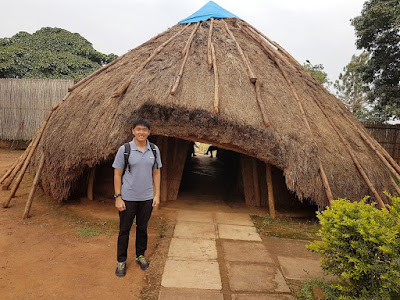JPN: Kumamoto Downtown
Kumamoto City, Kumamoto, Japan
My BFFs and I were greeted by figures of Kumamon inside the city's main railway station when we arrived. Of course, don't forget to catch it in action at Kumamon Square.
We happened to walk through Kuwamizumachi Park after the sun had set. It was a serendipitous moment, I must say.
Next, we made our way to Sakura Machi Kumamoto, a big shopping mall in town.
I recorded a bit of the rap done by the singer on stage. From the sound of it, I'm pretty sure it's part of an anime song.
Before leaving, we went up to the open spaces on the higher floors of the shopping mall to enjoy the night view.

Being the capital city of one of the prefectures in Kyushu that shares the same name, Kumamoto covers a total area of approximately 390 square kilometres. Having an abundant supply of high quality underground water, it's the place where the tradition of eating basashi (lit. raw horse meat) began, although nowadays the horse meat is considered a delicacy.
---
JPN: Hotel Sunline Fukuoka Hakata Ekimae
JPN: Nagahama Fish Market Centre
JPN: Korokan Ruins Museum
JPN: Maizuru Park
JPN: Ohori Park
JPN: Kushida Shrine
JPN: Tocho-ji & Shofuku-ji
JPN: Fukuoka Downtown
JPN: Fukuoka Uptown
JPN: Yufuin No Mori 3
JPN: Tenku Yubo Seikaiso
JPN: Seven Hells of Beppu (Part 1)
JPN: Seven Hells of Beppu (Part 2)
JPN: Beppu Downtown
JPN: Yufuin Kotobuki Hananosho
JPN: Yunotsubo Street
JPN: Kinrin Lake
JPN: Yufuin Downtown
JPN: Hotel Route-Inn Kumamoto Ekimae
JPN: Kumamoto Castle
JPN: Kumamon Square
JPN: Kumamoto Downtown <YOU ARE HERE!>
JPN: Tsubame 322 & Huis Ten Bosch 11
JPN: Hotel Okura JR Huis Ten Bosch
JPN: Town of Sasebo
JPN: Mameshiba Café
JPN: Huis Ten Bosch (Part 1)
JPN: Huis Ten Bosch (Part 2)
JPN: Nagahama Fish Market Centre
JPN: Korokan Ruins Museum
JPN: Maizuru Park
JPN: Ohori Park
JPN: Kushida Shrine
JPN: Tocho-ji & Shofuku-ji
JPN: Fukuoka Downtown
JPN: Fukuoka Uptown
JPN: Yufuin No Mori 3
JPN: Tenku Yubo Seikaiso
JPN: Seven Hells of Beppu (Part 1)
JPN: Seven Hells of Beppu (Part 2)
JPN: Beppu Downtown
JPN: Yufuin Kotobuki Hananosho
JPN: Yunotsubo Street
JPN: Kinrin Lake
JPN: Yufuin Downtown
JPN: Hotel Route-Inn Kumamoto Ekimae
JPN: Kumamoto Castle
JPN: Kumamon Square
JPN: Kumamoto Downtown <YOU ARE HERE!>
JPN: Tsubame 322 & Huis Ten Bosch 11
JPN: Hotel Okura JR Huis Ten Bosch
JPN: Town of Sasebo
JPN: Mameshiba Café
JPN: Huis Ten Bosch (Part 1)
JPN: Huis Ten Bosch (Part 2)
---
My BFFs and I were greeted by figures of Kumamon inside the city's main railway station when we arrived. Of course, don't forget to catch it in action at Kumamon Square.
After checking into Hotel Route-Inn Kumamoto Ekimae, we made our way to Suizenji Jojuen without checking beforehand that it's only open until 5.00pm daily from early November to end February. It's a spacious Japanese style landscape garden built in the 17th century. Nevertheless, we had a good walk before dinner.
 |
| Such a long and thin multi-storey car park! |
 |
| The garden is located at the end of the mini shopping street. There's an admission fee of ¥400 (~S$5.05) per person. |
We had fun browsing the items sold at the gift shop not far from the entrance to the garden.
 |
| Somehow Ash's Pikachu seems bigger than that. |
 |
| Who'd expect to see a statue of Monkey D. Luffy from One Piece there? |
 |
| There's a live panel on groundwater table. |
I wonder how many dioramas of Kumamoto Castle are there in the city.
The following day, we took one of the city trams to go to Kumamoto Castle.
We took a look at Kumamoto-jo Inari Shrine after exploring the grounds of the castle.
 |
| The shrine was constructed for the divine protection of Kumamoto Castle in 1588. |
 |
| The omikuji (Japanese fortune-telling papers) are classified into many different categories. Those written in English cost ¥100 (~S$1.25) cost per piece. |
 |
| Many Hong Kong people have left similar messages in the various temples I visited during the trip. |
We also wandered about Shimotori Shitengai, which is the largest shopping arcade in the city.
 |
| Flags of various countries are hung throughout the shopping arcade. Can you identify the four flags in the photo? |
Another well-known shopping arcade is the smaller Kamitori Shotengai.
 |
| Do you like red bean pancakes? |
 |
| A festival celebrating manga, anime and pop culture was held outside the shopping mall. |
 |
| Beef tongue, anyone? I've only had that once in my life not in Japan, but in Singapore. |
I recorded a bit of the rap done by the singer on stage. From the sound of it, I'm pretty sure it's part of an anime song.
Also held outside the shopping mall was the annual Christmas Market Kumamoto.
 |
| Hello, cute dogs! |
 |
| Have you had black lemonade before? I'm sure it gets its colour from activated charcoal. |
 |
| Isn't the best gift during Christmas the presence of a happy family all wrapped up in each other? |
 |
| The aroma of sausages from that stall was really inviting. |
 |
| Kumamoto hosted the 2019 World Women's Handball Championship. Back then, it hosted the 1997 World Men's Handball Championship, the first one outside of Europe. |
Even after walking so much for the day, we still went to walk back to the hotel.
 |
| It's a work of art depicting a particular festival, methinks. |

Below are the places we bought food from in Kumamoto:
- Ajisen Ramen (Japanese)
- Foodway (Japanese)
- Obento No Hirai (Japanese)
- Sugano-Ya (Japanese and Western)
- Ajisen Ramen (Japanese)
- Foodway (Japanese)
- Obento No Hirai (Japanese)
- Sugano-Ya (Japanese and Western)





































Comments
Post a Comment